
Anna Virnich LANGES FÄDCHEN FAULES MÄDCHEN
Leipzig 14 Jan – 8 Apr 2023
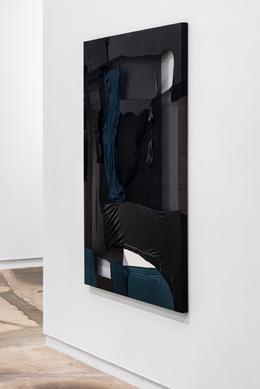
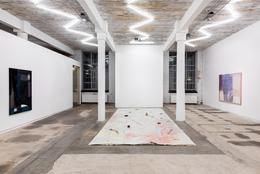
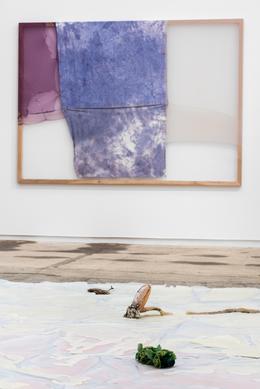
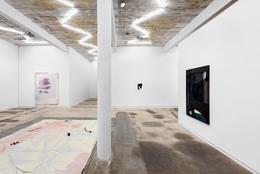
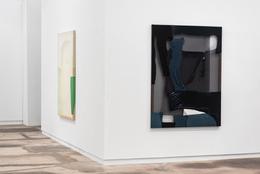
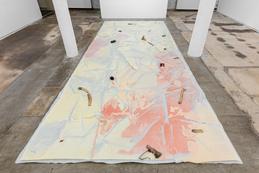
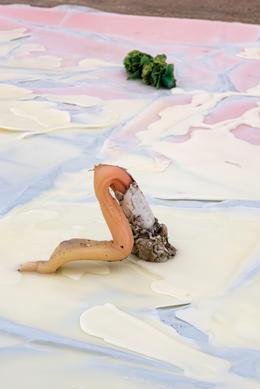
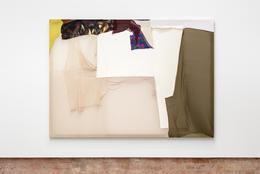
Langes Fädchen faules Mädchen (Long Thread Lazy Girl)
Naturally Anna Virnich’s art can initially be read as abstract painting. However, how things proceed after this first impression is not so clear. Why painting actually? And what painting? So, first of all: painting, because frame, canvas, paint, because gesture, mark, form – that, reduced to the essentials and a rigid set of simple elements, provides the basis – precisely because of this simplicity and boundedness – for endless modulation, which can be used anew every time to spell feeling, subjectivity and individuality (and its entanglement in the world).
Naturally Virnich’s painting still displays a certain reflexive “twist”. Twist because: sewn fabrics – sometimes painted, sometimes left unpainted – instead of canvas, stretched over frames that shimmer though and thus reveal themselves as supports; textile fragments instead of a plane; seams and stitches instead of brushstrokes; and finally, different fabric surfaces and textile web structures instead of a coarse or fine, a thick-pastose or vanishingly thin application of paint.
Through the use of different materials, and very generally the emphasis on the textiles, Virnich lends her pictures something enchantingly beautiful. She charges them, sensually and haptically. In the process, by means of a sophisticated, almost invisible artifice, painting becomes sewn to create a Frankensteinian body of the second order, in which the material carriers (frame, canvas, paint) become fused with the carriers of subjective expression (form, mark, gesture). In other words “painting (in quotation marks)”. Whether this results in something being disguised as painting, or the disguising of painting itself, remains subtly in the balance.
Five of these painting (all 2022), typical for Virnich, can also be found in her exhibition “Long Thread Lazy Girl”: abstract landscapes, made from fabrics, each with very different haptics – vanishingly thin and bandage-like gauze, polyester fabrics with lustrous and iridescent surfaces, painted silk scarves, flexible latex, materials with a stronger structure such as sequined cloth or tulle. Some of them are painted or partially dyed, others have been sewn together without further treatment and stretched over the frames, resulting in creases, deformations or overlaps. The material itself constitutes the sign.
For a new series of small format works produced for this exhibition called “Nervenkostüme” (English: nerves, or translated literally Nerve Costumes) all from 2022, Virnich does without frames entirely for the first time. The corresponding works are hung, gently stretched, directly on the walls, which thus mutate into a “painting support”. The interlacing of support material and applied gesture, as characterized by Virnich’s textile works stretched over frames, is dissolved again – or to keep to the sewing vocabulary: “unstitched”. The result of this is that the gesture (now formulated, once again, in the linguistic register of painting) can “spill” out into the space: The painterly as a specific gaze imposes itself on the perception of the whole space. And Virnich’s paintings unite with the rough and unevenly mottled floors and ceilings of the gallery rooms in the former Leipzig cotton spinning mill.
The porosity and openness which is intrinsic to the whole exhibition is already concealed in the title of the new series, which once again dresses the sensorium of feeling and perceiving in the vocabulary of textiles: According to the Duden dictionary, “Nervenkostüm” is a colloquial expression for the “nervous system with respect to its resilience” – whereby it should be added that in its everyday use it generally applies to weak and therefore especially permeable nerves.
The last work, which has been created in the room and only for the duration of the exhibition, also makes use of the painterly principle – and in the same breath leaves it behind. Using wax that originally came from a floor work from her 2019 exhibition “Hyperdrüse” (Hypergland) at Berlin’s Schering Foundation, Virnich has created an abstract floor work called “Limbic” in the central room of the gallery. Yellowish and pink in color, additionally smelling of a specially designed scent, the extremely changeable material flows, intertwining, to generate forms and patterns which are only partially controllable. Between them lie strange artefacts, equivalent to gestural markings. Virnich cast them in 2021, also from the wax used in the “Hyperdrüse" exhibition, exposing them to the cycle of the seasons for the duration of a year in the Uckermark, mainly in the form of long, candle-like stele. They are now partially melted, broken, discolored and enriched with small stones, moss and all kinds of other remnants – surreal found objects from another world. Taken together they form a floor painting with abstract areas of color, markings and gestures, all spread out over a large tarpaulin which functions as a gigantic horizontal canvas: a picture of painting, but in terms of dimensions, material, presentation and smell it has long since become something completely different; something that has literally stepped over the borders, has burst the frame – a dream landscape, composed of past things, of memories, which, as the title already indicates with its reference to the limbic system, a very old part of the brain, which amongst other things is responsible for the emotions, is emotionally colored.
At the latest, with this most recent work, the painterly reveals itself in this exhibition to be less (or at least not just) a question of media but a specific sensorium, a specific form of perception and the resulting praxis – an abstract and simultaneously extremely concrete-tangible and sometimes surreal depiction of a dream landscape using the means of the world; it shows itself less as a rigid game for aficionados using the limited elements of a media setup, and far more as an imaginative, tentative-imaginative process of exploring and shaping the world on the basis of the existing, or more precisely, as step-by step movement carried out on and in the material. The one does not exclude the other, however it does make a difference in terms of the approach and its interpretation. The world, that is everything that can be painted; all that one can depict, using whatever means.
© Dominikus Müller, 2023
Anna Virnich (born 1984, Berlin) lives and works in Berlin. Her work draws from a wide range of materials and formal references. Textile tableaux form the centre of her multimedia practice and testify to her unconventional engagement with the medium of painting as part of a network of exchanges between substances, technologies, bodies, pictures and the light in the eyes.
Naturally Anna Virnich’s art can initially be read as abstract painting. However, how things proceed after this first impression is not so clear. Why painting actually? And what painting? So, first of all: painting, because frame, canvas, paint, because gesture, mark, form – that, reduced to the essentials and a rigid set of simple elements, provides the basis – precisely because of this simplicity and boundedness – for endless modulation, which can be used anew every time to spell feeling, subjectivity and individuality (and its entanglement in the world).
Naturally Virnich’s painting still displays a certain reflexive “twist”. Twist because: sewn fabrics – sometimes painted, sometimes left unpainted – instead of canvas, stretched over frames that shimmer though and thus reveal themselves as supports; textile fragments instead of a plane; seams and stitches instead of brushstrokes; and finally, different fabric surfaces and textile web structures instead of a coarse or fine, a thick-pastose or vanishingly thin application of paint.
Through the use of different materials, and very generally the emphasis on the textiles, Virnich lends her pictures something enchantingly beautiful. She charges them, sensually and haptically. In the process, by means of a sophisticated, almost invisible artifice, painting becomes sewn to create a Frankensteinian body of the second order, in which the material carriers (frame, canvas, paint) become fused with the carriers of subjective expression (form, mark, gesture). In other words “painting (in quotation marks)”. Whether this results in something being disguised as painting, or the disguising of painting itself, remains subtly in the balance.
Five of these painting (all 2022), typical for Virnich, can also be found in her exhibition “Long Thread Lazy Girl”: abstract landscapes, made from fabrics, each with very different haptics – vanishingly thin and bandage-like gauze, polyester fabrics with lustrous and iridescent surfaces, painted silk scarves, flexible latex, materials with a stronger structure such as sequined cloth or tulle. Some of them are painted or partially dyed, others have been sewn together without further treatment and stretched over the frames, resulting in creases, deformations or overlaps. The material itself constitutes the sign.
For a new series of small format works produced for this exhibition called “Nervenkostüme” (English: nerves, or translated literally Nerve Costumes) all from 2022, Virnich does without frames entirely for the first time. The corresponding works are hung, gently stretched, directly on the walls, which thus mutate into a “painting support”. The interlacing of support material and applied gesture, as characterized by Virnich’s textile works stretched over frames, is dissolved again – or to keep to the sewing vocabulary: “unstitched”. The result of this is that the gesture (now formulated, once again, in the linguistic register of painting) can “spill” out into the space: The painterly as a specific gaze imposes itself on the perception of the whole space. And Virnich’s paintings unite with the rough and unevenly mottled floors and ceilings of the gallery rooms in the former Leipzig cotton spinning mill.
The porosity and openness which is intrinsic to the whole exhibition is already concealed in the title of the new series, which once again dresses the sensorium of feeling and perceiving in the vocabulary of textiles: According to the Duden dictionary, “Nervenkostüm” is a colloquial expression for the “nervous system with respect to its resilience” – whereby it should be added that in its everyday use it generally applies to weak and therefore especially permeable nerves.
The last work, which has been created in the room and only for the duration of the exhibition, also makes use of the painterly principle – and in the same breath leaves it behind. Using wax that originally came from a floor work from her 2019 exhibition “Hyperdrüse” (Hypergland) at Berlin’s Schering Foundation, Virnich has created an abstract floor work called “Limbic” in the central room of the gallery. Yellowish and pink in color, additionally smelling of a specially designed scent, the extremely changeable material flows, intertwining, to generate forms and patterns which are only partially controllable. Between them lie strange artefacts, equivalent to gestural markings. Virnich cast them in 2021, also from the wax used in the “Hyperdrüse" exhibition, exposing them to the cycle of the seasons for the duration of a year in the Uckermark, mainly in the form of long, candle-like stele. They are now partially melted, broken, discolored and enriched with small stones, moss and all kinds of other remnants – surreal found objects from another world. Taken together they form a floor painting with abstract areas of color, markings and gestures, all spread out over a large tarpaulin which functions as a gigantic horizontal canvas: a picture of painting, but in terms of dimensions, material, presentation and smell it has long since become something completely different; something that has literally stepped over the borders, has burst the frame – a dream landscape, composed of past things, of memories, which, as the title already indicates with its reference to the limbic system, a very old part of the brain, which amongst other things is responsible for the emotions, is emotionally colored.
At the latest, with this most recent work, the painterly reveals itself in this exhibition to be less (or at least not just) a question of media but a specific sensorium, a specific form of perception and the resulting praxis – an abstract and simultaneously extremely concrete-tangible and sometimes surreal depiction of a dream landscape using the means of the world; it shows itself less as a rigid game for aficionados using the limited elements of a media setup, and far more as an imaginative, tentative-imaginative process of exploring and shaping the world on the basis of the existing, or more precisely, as step-by step movement carried out on and in the material. The one does not exclude the other, however it does make a difference in terms of the approach and its interpretation. The world, that is everything that can be painted; all that one can depict, using whatever means.
© Dominikus Müller, 2023
Anna Virnich (born 1984, Berlin) lives and works in Berlin. Her work draws from a wide range of materials and formal references. Textile tableaux form the centre of her multimedia practice and testify to her unconventional engagement with the medium of painting as part of a network of exchanges between substances, technologies, bodies, pictures and the light in the eyes.
Artists
- Anna Virnich